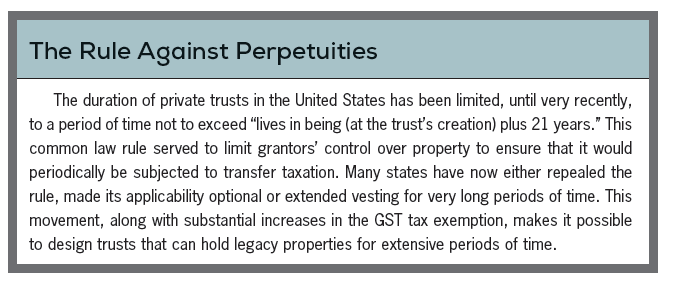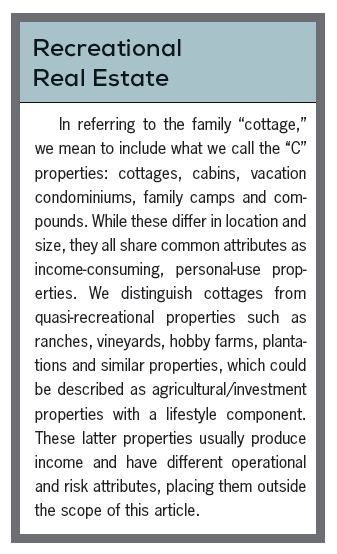In the fall 2016 issue of Private Wealth (“The Cottage Succession Plan,”) we discussed the use of a limited liability company (LLC) for transferring ownership of, and managing, the family cottage for the use and enjoyment of next generation family members. This structure has significant advantages over a tenancy in common arrangement by limiting alienation and partition rights, and reducing the risk of creditor claims inherent in tenancy in common ownership. An LLC structure also provides flexibility for addressing issues common to these types of properties: shared usage, expense allocation maintenance, and the redemption/liquidation rights of individual family members.
ensure its regular use, the trustee was required to sell the property if the family did not use it at least 120 days per year. This was a high bar that the grantor had not discussed with his family. The four children, all of whom were young working adults, would have found this requirement onerous, even without life events such as international work assignments, health issues, etc. Fortunately, the grantor drew the family into the planning process. Family members were unable to convince the grantor to eliminate the use requirement, but they were able to encourage him to reduce it to a more realistic number.
For some families, however, a cottage’s unique role in family legacy is so important that the current generation may wish to provide for its sustained use by multiple, future generations. This type of legacy cottage is not viewed as part of the financial inheritance of descendants because it has exponentially more intrinsic, rather than financial, value. For such a family, while the legacy cottage is categorized as part of the family’s financial capital on their balance sheet, its role in sustaining and strengthening a family’s human and social capital outweighs its pecuniary value as an inheritable asset. This type of property requires more than a simple LLC.
The Irrevocable, Multigenerational Trust
A viable plan for such a legacy cottage would still involve an LLC to hold title to the property and provide an operating agreement for the regular maintenance and management of the cottage. But the LLC’s sole member would be an irrevocable, multigenerational trust. Such a trust would describe the cottage’s distinctive legacy role for the family through a carefully drafted statement of intent. The unique characteristic of this memorialized intent is that it clearly describes the purpose behind ownership while taking into account the cottage’s recreational benefits. These benefits, however, do not come without costs.
In a one-generation cottage LLC, the operating agreement typically provides for the family members to share expenses with a very minimal, if any, cash endowment. For a legacy cottage trust, an endowment managed by the trustee would provide cash flow for the maintenance, management and periodic improvement of the property. Ideally, the trust would be exempt from the generation-skipping transfer (GST) tax to guard against diminution from future transfer taxes, and it would not be subject to the rule against perpetuities.

One family developed a unique plan for their lake compound, placing cottages in separate LLCs aligned with family branches, all of them owned by an irrevocable trust. The individual LLCs allow each family to work independently on usage and maintenance, costs of which are funded through an endowment held in the trust. The trust includes a purpose-driven statement of intent describing the compound’s unusual history, its role in facilitating individual and family well-being and the grantors’ hopes for its future. This purpose is strengthened by a unique provision that would permit sale of a cottage only in rare circumstances, upon which the proceeds of sale pour over to the family foundation. This pour-over provision serves as a disincentive to attempt to alter the grantors’ plan for the cottage’s role in sustaining the family’s human capital: Monetization of the cottage will increase the family’s charitable, rather than financial, capital.
 Supporting Long-Term Goals
Supporting Long-Term Goals
Discussing long-term goals for legacy properties with descendants is vital to ascertain their commitment to the cottage. If family members support the goal of maintaining the cottage for future generations, they should be involved in long-term planning for the cottage. Otherwise plans can easily go awry. For example, in one case we are familiar with, a grantor developed a plan for an irrevocable trust to maintain the family’s mountainretreat. To
The usage requirement for the mountain retreat illustrates one of the challenges in working with grantors to assist them in crafting a meaningful, yet workable, statement of intent. We believe that these statements play a central role in expressing what the Uniform Trust Code calls the trust’s “material purpose.” A well-crafted statement of intent will: (1) express the family’s values and aspirations related to the cottage; (2) connect these values and hopes to the beneficiaries’ well-being; (3) provide guidance and a means of dealing with future circumstances, both anticipated and unforeseeable; and (4) provide a mechanism for resolving conflict among beneficiaries.
Long-term, multigenerational trusts of any kind navigate the tension between freedom of disposition, the potential of which has been greatly extended by the repeal of the rule against perpetuities and the increase in the GST tax exemption, and the growing desire of beneficiaries to deal with trust assets as if they were their own. This tension is not new, but it must be resolved in every long-term trust by finding the proper balance between grantor intent, beneficiaries’ well-being and the need for fiduciary flexibility to address rapid demographic changes.
The Legacy Cottage
December 2016
« Previous Article
| Next Article »
Login in order to post a comment








